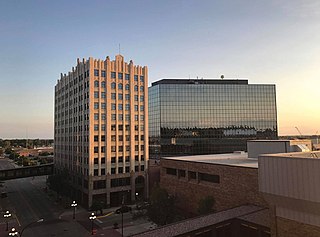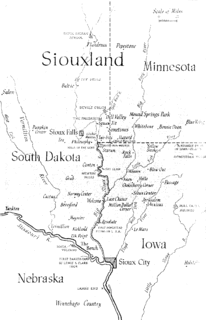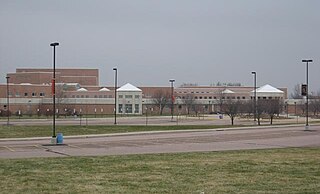Related Research Articles

Sioux City is a city in Woodbury and Plymouth counties in the northwestern part of the U.S. state of Iowa. The population was 82,684 in the 2010 census, which makes it the fourth-largest city in Iowa. The bulk of the city is in Woodbury County, of which it is the county seat, though a small portion is in Plymouth County. Sioux City is located at the navigational head of the Missouri River. The city is home to several cultural points of interest including the Sioux City Public Museum, Sioux City Art Center and Sergeant Floyd Monument, which is a National Historic Landmark. The city is also home to Chris Larsen Park, commonly referred to as "the Riverfront", which includes the Anderson Dance Pavilion, Sergeant Floyd Riverboat Museum and Lewis and Clark Interpretive Center. Sioux City is the primary city of the five-county Sioux City, IA–NE–SD Metropolitan Statistical Area (MSA), with a population of 168,825 in 2010 and a slight increase to an estimated 169,405 in 2018. The Sioux City–Vermillion, IA–NE–SD Combined Statistical Area had a population of 182,675 as of 2010 but had decreased to an estimated population of 178,448 as of 2018.

Sioux Falls is the most populous city in the U.S. state of South Dakota and the 140th-most populous city in the United States. It is the county seat of Minnehaha County and also extends into Lincoln County to the south, proximate with the Iowa state line.

The University of South Dakota (USD) is a public research university in Vermillion, South Dakota. Established by the Dakota Territory legislature in 1862, 27 years before the establishment of the state of South Dakota, USD is the flagship university for the state of South Dakota and the state's oldest public university. It occupies a 274 acres (1.11 km2) campus located in southeastern South Dakota, approximately 63 miles (101 km) southwest of Sioux Falls, 39 miles (63 km) northwest of Sioux City, Iowa, and north of the Missouri River.

The Big Sioux River is a tributary of the Missouri River, 419 miles (674 km) long, in eastern South Dakota and northwestern Iowa in the United States. The United States Board on Geographic Names settled on "Big Sioux River" as the stream's name in 1931. The river was named after the Lakota people.

Siouxland is a vernacular region that encompasses the entire Big Sioux River drainage basin in the U.S. states of South Dakota, Minnesota, Nebraska and Iowa. The demonym for a resident of Siouxland is Siouxlander.
The Sioux City metropolitan statistical area, as defined by the United States Census Bureau, is an area consisting of five counties in three states – Iowa, Nebraska, and South Dakota, anchored by the city of Sioux City, Iowa. As of the 2010 census, the MSA had a population of 168,825. In the future, Wayne County would be considered by some people and politicians as an additional sixth county.

The DakotaDome is a 10,000-seat multi-purpose stadium on N. Dakota Street in Vermillion, South Dakota. Opened in 1979 for a cost of $8.2 million, it is home to the University of South Dakota Coyotes for numerous athletic events, including football, men's and women's swimming and diving, and track. The DakotaDome was also the home site for the NAIA school Briar Cliff University football team from 2013 until 2017, when they re-located 25 miles to the southeast to Sioux City, Iowa, which is where their campus is located. The DakotaDome hosts other events throughout the year, including the South Dakota high school football championships each November. In 2014 a proposal for a new basketball arena went through and construction began just south of the Dome. The new arena, the Sanford Coyote Sports Center, which seats 6,000, first opened for the 2016 women's volleyball season.
The North Dakota Fighting Hawks represent the University of North Dakota, competing as an independent program in the NCAA Division I's Football Championship Subdivision. From 1973 to 2008, they played in the NCAA's NCAA Division II, winning the National Championship in 2001. From 1955 to 1972, they competed in the NCAA's College Division where they participated in and won three bowl games.
The University of Sioux Falls (USF) is a private Christian university in Sioux Falls, South Dakota. The university was founded in 1883. In fall 2014, the university enrolled a total of 1,142 undergraduate students and 311 graduate students.

Washington High School is a public secondary school located in Sioux Falls, South Dakota with an enrollment of 1,831 students. The school is part of the Sioux Falls School District, and is one of three public high schools in Sioux Falls.

The Sioux Falls Metropolitan Statistical Area, as defined by the United States Census Bureau, is an area consisting of four counties in South Dakota, anchored by the city of Sioux Falls. The metro area is referred to locally as the Sioux Empire. Despite the name, it is considered a part of the larger area known as Siouxland as it is within the Big Sioux River basin. As of the 2010 census, the MSA had a population of 228,261.
The Missouri River Activities Conference is a high school athletic and activities conference whose members are located in either the Sioux City Metropolitan Area or the Omaha-Council Bluffs Metropolitan Area, both located along the Missouri River on the border of western Iowa.

The Siouxland Conference is a ten team high school athletic conference in the northwest corner of Iowa, consisting of schools ranging from the smallest class (1A) to the second largest class (3A), and known for its prominence in small school basketball.
Calamus Wheatland High School is a four-year comprehensive high school located in Wheatland, Iowa. The school is part of the Calamus-Wheatland Community School District, and has an enrollment of approximately 120 students in grades nine through 12.

Akron Westfield High School and Middle School is a secondary school within the Akron-Westfield Community School District in Akron, Iowa, United States. The area served by this school was officially merged from Akron and Westfield school districts in 1981. Their mascot is "The Westerner". Akron was a member of the Siouxland Conference from 1952 to 1975 before consolidation with Westfield, and then known as the Red Raiders. The school then joined the Little Sioux Conference and now competes in the War Eagle Conference.

Boyden–Hull Junior/High School is the only public middle and high school located in Hull, Iowa, United States. It is a part of the Boyden–Hull Community School District. Their mascot is the Comet. The school's athletic teams compete in the Siouxland Conference. A few sports are shared with Rock Valley High School, a fellow Siouxland Conference member. The combined teams are known as the Nighthawks.
Sheldon High School is a public high school in Sheldon, Iowa, serving students of the Sheldon Community School District in grades 9-12. The school mascot is the Orab, a portmanteau of the school colors, orange and black. Athletic competitions have taken place in the Siouxland Conference since 2009, when the school moved from the Lakes Conference.
Boyden–Hull Community School District is a school district headquartered in Hull, Iowa.
West Sioux Community School District is a school district headquartered in Hawarden, Iowa. It operates Ireton Elementary School, Hawarden Elementary School, and West Sioux Middle School/High School in Hawarden.
References
- ↑ "West Sioux Joins New Conference; Blake is President". Hawarden Independent. October 22, 1964. Retrieved May 9, 2020.
- ↑ "Sioux Empire Conference Formed". Sioux Center News. October 22, 1964. Retrieved May 9, 2020.
- ↑ "High School Baseball Season to Open May 20". Sioux Center News. May 13, 1965. Retrieved May 9, 2020.
- ↑ Egan, John (October 22, 1964). "Vermillion and Canton Join Loop". Argus Leader. Retrieved May 9, 2020.
- ↑ "Conference (continued)". Sioux Center News. October 22, 1964. Retrieved May 9, 2020.
- ↑ "(Sioux Center and Central) Lyon Join Siouxland Conference". The Sioux County Index. January 26, 1967. p. 1. Retrieved May 9, 2020.
- ↑ "Football facts concerning W. Sioux". Hawarden Independent. August 29, 1974. Retrieved May 9, 2020.
| This article related to sports in Iowa is a stub. You can help Wikipedia by expanding it. |
| This article related to sports in South Dakota is a stub. You can help Wikipedia by expanding it. |